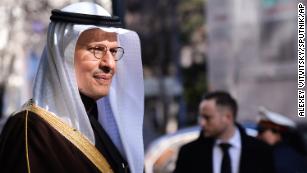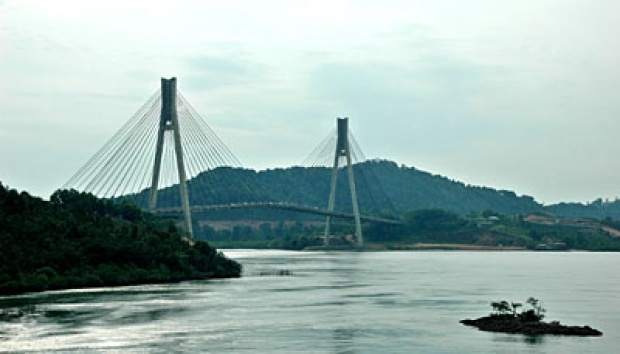Live Streaming
Program Highlight
Company Profile

Ani Hasanah
March

Oil prices suffered an historic collapse overnight after Saudi Arabia shocked the market by launching a price war against onetime ally Russia.
US oil prices crashed as much as 34% to a four-year low of $27.34 a barrel as traders brace for Saudi Arabia to flood the market with crude in a bid to recapture market share.
Crude was recently trading down 27% to $30.04 a barrel. Brent crude, the global benchmark, plunged 26% to $33.49 a barrel. Both oil contracts are on track for their worst day since 1991, according to Refinitiv.
The shock to oil also rattled equity markets, which were already in a panic because of the novel coronavirus outbreak. Stocks in Asia plunged during Monday trading hours, while US futures recorded massive declines.
The turmoil comes after the implosion of the oil alliance between OPEC and Russia on Friday.
Russia refused to go along with OPEC's efforts to rescue the coronavirus-battered oil market by cutting production. The failure of the Vienna meeting left the oil industry shell-shocked, sparking a 10% plunge in oil prices Friday. Oil prices were already stuck in a bear market because of the coronavirus outbreak that has caused demand for crude to fall sharply.
But then Saudi Arabia escalated the situation further over the weekend. The kingdom slashed its April official selling prices by $6 to $8, according to analysts, in a bid to retake market share and heap pressure on Russia.
"The signal is Saudi Arabia is looking to open the spigots and fight for market share," said Matt Smith, director of commodity research at ClipperData. "Saudi is rolling up its sleeves for a price war."
The biggest one-day percentage drop for US oil prices this century occurred in September 2001 when they plunged 15%, according to Refinitiv statistics that go back to 2000.
Analysts said that Russia's refusal to cut production amounted to a slap to US shale oil producers, many of which need higher oil prices to survive.
"Russia has been dropping hints that the real target is the US shale oil producers, because it is fed up with cutting output and just leaving them with space," analysts at energy consulting firm FGE wrote in a note to clients Sunday. "Such an attack may be doomed to failure unless prices remain low for a long time."
The 2014-2016 oil crash caused dozens of oil and gas companies to file for bankruptcy and hundreds of thousands of layoffs. However, the US shale industry emerged from that period stronger and the United States would eventually become the world's leading oil producer.
"The perils of playing a game of brinksmanship with Vladimir Putin were proven in dramatic fashion," Helima Croft, head of global commodity strategy at RBC Capital Markets, wrote in a Friday note to clients. "It is hard to see how the relationship can easily be put back on a solid footing." (CNN)
UAE Celebrates International Women's Day as Reflection of National Ambitions
Women in the United Arab Emirates joined the international community on Sunday in celebrating International Women’s Day. The Middle Eastern country represents a beacon of hope for the advancement of women's empowerment in a region, which has been predominantly patriarchal, according to the UAE government.
The annual celebration is commemorated every March 8 to acknowledge women’s role and contributions to political, cultural, social and economic development.
In a statement made available to The Jakarta Post on Sunday, the Emirati government through its missions in Jakarta said the country had taken a strong position in women's empowerment.
“Women have been the key partner of the development in the country and have been playing a vital role in elevating [the capabilities] of UAE’s future generation,” the statement read.
UAE President Sheikh Khalifa bin Zayed Al-Nahyan has taken a clear position to empower women in the country by encouraging them to assume some of the highest positions in various sectors.
“Some of the ministerial posts within the Emirati government is being assumed by women. Some are also holding their positions as officials of the Federal National Council,” the UAE government said, adding that women had also maintained a decisive role in the country’s justice system.
In 2012, the UAE became the first country in the Arab region to allow women to participate as councillors.
The country’s constitution guarantees equal rights between men and women, which helped the emirates leader in various gender equality indices, supplementing its advances in education and literacy.
The UAE acknowledges that women’s participation in decision-making was a key factor in the country’s economic development. In 2012, for instance, the UAE government decided to give more leverage to women in leadership, allowing them to sit in the highest position in every institution.
Ever since, around 15 percent of the available seats in government institutions must be allocated to women and 50 percent for the Federal National Council, aligning with Al-Nahyan’s vision to further involve women in developing the country’s vital sectors.
“At least nine out of the 32 ministers in the current government are women. In the Foreign Affairs and International Cooperation Ministry, for instance, almost half of the employees are women,” the statement said.
The Gulf state bears the world's highest percentage of women in the public sector at 66 percent, of which 30 percent are in positions of leadership or related to decision-making.
At least 75 percent of the positions in the education and healthcare sectors are filled by women. Two-thirds of the country’s university graduates are women, of which 77 percent studied computer sciences and another 44 percent specializing in engineering – more than twice as many than in Western Europe or the United States.
In 2014, the UAE also opened the Khawla bint Al Azwar Military School as the first military academy for women in the region.
Currently, at least 23,000 women entrepreneurs in the UAE are running projects worth US$13.6 billion. Around 19 percent of the members of the country’s chamber of industry and commerce are women.
As such, the UAE has committed to empowering women globally to take on greater roles in entrepreneurship and has contributed at least $50 million to the Women Entrepreneurs Finance Initiative (We-Fi), a collaborative partnership among 14 governments, eight multilateral development banks (MDBs) and other public and private sector stakeholders hosted by the World Bank Group.
March

Following the direct order from President Jokowi, Head of Riau Island’s Center for Settlement Infrastructure Albert Reinaldo announced that the construction of a hospital specifically built to treat communicable diseases has started at Riau Island’s Galang Island, Batam City.
The sub-agency of the Public Works and Public Housing Ministry’s directorate-general announced that the land at the island has been cleared and awaits for the next phase; land maturation.
“The work has started on Saturday, March 7. Land clearing is nearly done,” said Albert at Batam on Sunday, March 8. “The hospital we will build there is hoped to be free from floods.”
The hospital is set on 7 - 8 hectares of land sitting over land formerly used as “camp Vietnam” but did not reveal plans as what would be done on the old hospital facility that remains in the location. As of now, a hospital and house of worship reminiscent of the island’s older facilities remain.
President Joko “Jokowi” Widodo previously ordered for the construction of a hospital in an isolated location to specially treat patients with highly-infectious diseases such as the current COVID-19 coronavirus global outbreak that originated from China’s province of Wuhan.
The president also ambitiously ordered the project to be completed within one month.
Moreover, to meet the president’s deadline, the Galang Island hospital will be constructed using the same method used by the Chinese government in building the two hospitals to treat coronavirus patients that was completed under two weeks.
“We will adopt a modular system such as the one in Wuhan. Which we hope will accelerate the construction apart from the materials that are being produced in Jakarta,” said Albert. (tempo.co)
Australia’s economy will record its first recession since 1991 as the hit from China’s virus-induced slowdown is amplified by slumping confidence and domestic disruptions as the outbreak intensifies Down Under, according to Bloomberg Economics’s James McIntyre.
Gross domestic product will fall 0.4 percentage point in the first three months of the year and 0.3 percentage point in the second quarter, ending a 28-1/2-year stretch of economic growth, he said in a report Monday.
“Isolations and domestic disruptions to contain the spread of the virus will have a mounting economic impact, which is likely to result in a further GDP contraction in 2Q and potentially beyond,” McIntytre said. “Stimulus, both fiscal and monetary, will help to reduce the damage, but is unlikely to be enough to offset the impacts.”
McIntyre forecasts GDP to grow by 0.4 percent in 2020, some 1.5 percentage points below his pre-coronavirus forecast.
The Reserve Bank cut interest rates last week and money markets are pricing in a further reduction in April, which would bring it to the estimated lower bound of 0.25% and open the door to unconventional policy. The government is finalizing a fiscal “boost” that could amount to A$10 billion ($6.6 billion) to support firms struggling with cash flow and help them keep on employees.
McIntyre predicts large budget deficits ahead as the automatic stabilizers -- increased welfare payments and reduced tax collection -- begin to take hold. That’s on top of the fiscal stimulus needed to boost demand and confidence.
The Treasury and RBA estimate the impact on tourism and education from China’s shutdown and other virus fallout will cut 0.5 percentage point from GDP in the first quarter. That doesn’t include supply chain disruptions and is in addition to a 0.2 point cut from wildfires over summer.
McIntyre said the comparison with the 2003 SARS epidemic is problematic because of the massive increase of China’s importance to both the Australian and global economies. He notes that in the Australian Dollar Trade-Weighted Index of the exchange rate, the weighting of the renminbi rose to 30 percent, higher than any other currency in the 36-year history of the gauge.
McIntyre notes that the channels through which the reduction in domestic activity transmits during a pandemic were laid out in a 2006 Treasury paper whose author is Steven Kennedy, the current secretary to the Australian Treasury. That analysis saw the economy contracting 5% in the first year.
Transmission of the virus in Australia is now occurring, meaning disruptions and shutdowns of aged-care facilities, child-care centers and schools. Health authorities anticipate several months of disruptions from the virus.
McIntyre predicts the economy will bounce back, noting that fourth-quarter GDP released last week showed several segments turning around, including housing and mining investment. China is also set to stimulate its economy, which traditionally benefits Australia.
Property prices Down Under have surged since late last year when the RBA resumed easing.
“How Australia’s housing market weathers the virus outbreak will be a key area of interest given the earlier downturn in construction activity,” he said. “Australia’s resources sector also stands well placed to benefit from a resumption of activity in China’s construction sector and stimulus measures.” (The Jakarta Post)



